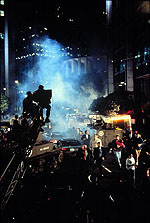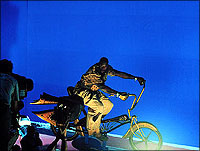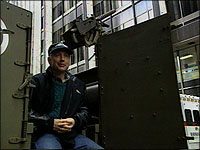 |
|

|
The Making of Special EffectsBy Kelly TylerReprinted by permission of "The Big Frame."  Impress me. That's what today's film audiences are saying. The standard is
continually being raised—Terminator 2: Judgment Day, Jurassic Park,
Jumanji. So what's next? "Everyone's going for bigger and better, so we
decided why not ten times bigger? The filmmakers we worked with loved
the whole new dimension this medium gave them—and loved giving away their
secrets for the camera," says Susanne Simpson, producer of Special
Effects, the latest large format production of NOVA/WGBH Boston.
Impress me. That's what today's film audiences are saying. The standard is
continually being raised—Terminator 2: Judgment Day, Jurassic Park,
Jumanji. So what's next? "Everyone's going for bigger and better, so we
decided why not ten times bigger? The filmmakers we worked with loved
the whole new dimension this medium gave them—and loved giving away their
secrets for the camera," says Susanne Simpson, producer of Special
Effects, the latest large format production of NOVA/WGBH Boston.Distributed by Imax Corporation, Special Effects reveals the method behind the magic of the movies, and features state-of-the art effects created exclusively for the film in IMAX, from a 1990s-style King Kong to a history-making recreation of shots from Star Wars.  The documentary goes behind-the-scenes on four major feature films to see how
it's done: Lucasfilm Ltd. and Twentieth Century Fox's Star Wars Special
Edition, Disney/Interscope Communications' Kazaam!, Fox's
Independence Day and TriStar Pictures' Jumanji. But creating a
better illusion is more than technology—it's the perceptual sleight-of-hand
that makes it possible. "The science story is a natural, because special
effects are all about perception," says NOVA executive producer Paula Apsell.
"Knowing how the eye and brain work is an integral part of creating convincing
effects."
The documentary goes behind-the-scenes on four major feature films to see how
it's done: Lucasfilm Ltd. and Twentieth Century Fox's Star Wars Special
Edition, Disney/Interscope Communications' Kazaam!, Fox's
Independence Day and TriStar Pictures' Jumanji. But creating a
better illusion is more than technology—it's the perceptual sleight-of-hand
that makes it possible. "The science story is a natural, because special
effects are all about perception," says NOVA executive producer Paula Apsell.
"Knowing how the eye and brain work is an integral part of creating convincing
effects." Special Effects is the third large-format film for NOVA, the
award-winning public television science series. NOVA's first two films, To
The Limit (1989) and Stormchasers (1995), were produced in
partnership with the Museum Film Network and MacGillivray Freeman Films. For
Special Effects, NOVA enlisted the support of 18 participating museums and
the National Science Foundation.
Special Effects is the third large-format film for NOVA, the
award-winning public television science series. NOVA's first two films, To
The Limit (1989) and Stormchasers (1995), were produced in
partnership with the Museum Film Network and MacGillivray Freeman Films. For
Special Effects, NOVA enlisted the support of 18 participating museums and
the National Science Foundation.In the Beginning..."Special Effects is the best example of an IMAX crossover film to date—one that will have wide audience appeal in both the education and entertainment marketplaces," says Mike McGrath, Imax's vice president of film distribution.Special Effects received exceptional backing from numerous Hollywood studios and archives, which allowed a treasure trove of footage and artifacts to appear in the film. In fact, Special Effects has been designated as an official project of the Motion Picture Centennial, an international celebration of the first 100 years of cinema.  Director Ben Burtt is excited about the historical aspect of the project. "The
history of special effects goes back to the invention of motion pictures.
There's a strong sense of tradition and continuity with the past in the
field." Burtt's own work is a part of motion picture history; as sound designer
for films from Star Wars to Raiders of the Lost Ark, he won
acclaim and four Academy Awardsreg. for his innovative sound design. Burtt's
IMAX debut came in 1986, as sound designer for The Dream Is Alive. In
addition, Burtt stepped behind the camera as principal director of Blue
Planet and contributed segments to Destiny In Space. Most recently,
Burtt directed Attack of the Hawkmen, a Young Indiana Jones film for
television.
Director Ben Burtt is excited about the historical aspect of the project. "The
history of special effects goes back to the invention of motion pictures.
There's a strong sense of tradition and continuity with the past in the
field." Burtt's own work is a part of motion picture history; as sound designer
for films from Star Wars to Raiders of the Lost Ark, he won
acclaim and four Academy Awardsreg. for his innovative sound design. Burtt's
IMAX debut came in 1986, as sound designer for The Dream Is Alive. In
addition, Burtt stepped behind the camera as principal director of Blue
Planet and contributed segments to Destiny In Space. Most recently,
Burtt directed Attack of the Hawkmen, a Young Indiana Jones film for
television.A Long Time Ago, in a Galaxy Somewhere Near San FranciscoSimpson's first choice for the film's visual effects was Industrial Light & Magic (ILM), founded by George Lucas to create special effects for the first Star Wars film. Since 1975, ILM artists have received 14 Academy Awards for best visual effects and 9 for technical achievements. With a reputation for breaking new ground in such films as Raiders of the Lost Ark, ET The Extra-Terrestrial, Jurassic Park and Terminator 2: Judgment Day, ILM was eager to take on the challenges of the IMAX medium. For technical expertise, NOVA turned to Christopher Reyna of IMAGICA USA, a pioneer in large-format special effects since serving as technical director of the restored 70mm triptych sequences of Abel Gance's Napoleon in 1981. ILM suggested a bold idea for their large-format debut: to recreate two of the most breathtaking shots from Star Wars, the opening intergalactic chase and the Millennium Falcon's jump to hyperspace. ILM visual effects supervisor Bruce Nicholson planned to film the original models and matte paintings with a motion controlled 65mm/15 perforation camera, scan the original negative and composite the elements digitally. Additional enhancements, such as a star field and nebulae, would be created entirely in the digital realm. But first, ILM had to configure a digital scanner capable of the vast resolution requirements necessary to meet the "gold standard" for 70mm/15 exhibition, a project directed by Josh Pines. Says Reyna, "The quality and scope of digital scanning and compositing on this project are unparalleled in large-format. It's an exceptional achievement." Nicholson recalls the accommodations necessary for the large-format. "Image fidelity was the key ingredient. Large format is very demanding in terms of sharpness—you can get away with a lot more in 35mm." The second part of the equation was sheer computing power: rendering the vast visual data of the IMAX frame required several days, where a 35mm shot of similar length requires hours of processing. Photo Credits: (1) Peter Iovino copyright 1996 WGBH Educational Foundation, (2) copyright 1996 WGBH Educational Foundation, (3) copyright 1995 Museum Film Network and WGBH Educational Foundation, (4) Ben Burtt Director of Special Effects copyright 1996 WGBH Educational Foundation . Theater Release Dates | Behind the Scenes |